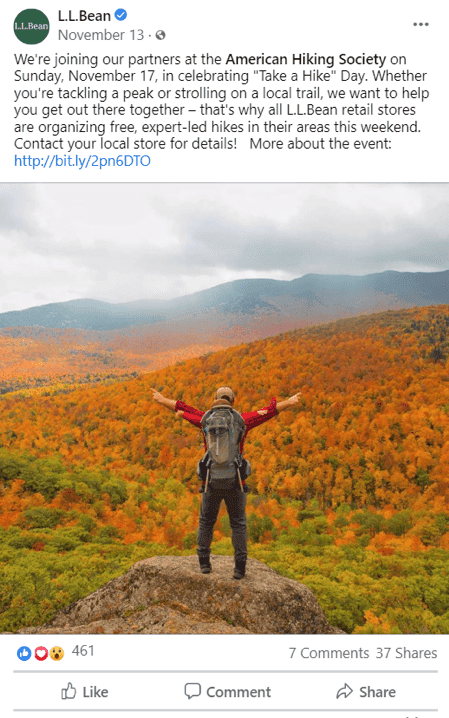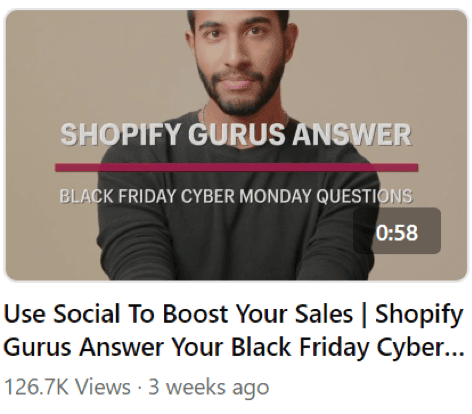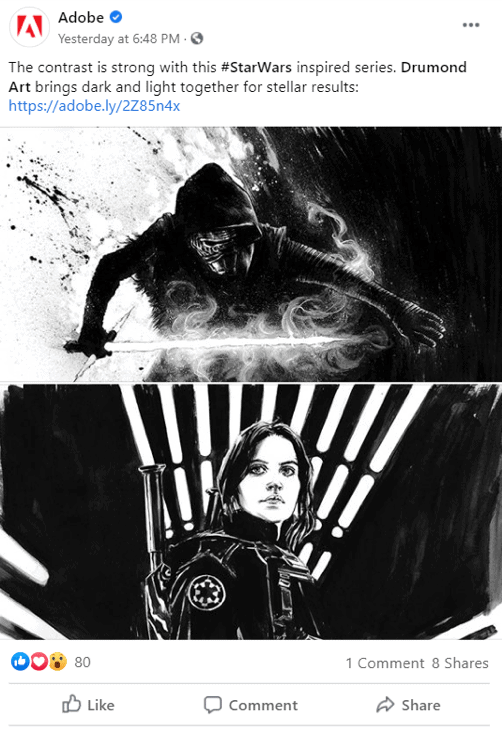
Let’s be honest: You’ve just seen an ad for Nutella, and you couldn’t care less.
But then you navigate to their Facebook page. Suddenly, videos of the luscious spread catch your eye. You find yourself immersed in the recipes, and before you know it, you’ve learned how to make Nutella pancakes, cupcakes, ganache, parfait, and dozens more.
Something about a company’s social media content has the power to attract an audience more than just a simple ad. Far from being boring or irritating, the best Facebook business pages compel you to follow them through sheer value and interest.
How, exactly, is a simple Facebook page able to cast such a spell? Below, we’ll talk about five of our favorite Facebook business pages. After that, we’ll share some tips and best practices so that you can create and brand a successful Facebook page for your small business.
We brought them up already (can you tell we’re obsessed?), but that’s because they’re worth the attention: Nutella’s hazelnut spread is hard to beat, and its Facebook page is just as good.
The company’s page shows some seriously mouthwatering imagery, taking full advantage of Facebook’s increasing emphasis on video. It seizes on the trend of Facebook video recipes and teaches us that, well, there’s an infinite amount of stuff we can do with Nutella.
The company gets creative with its recipes, too, tantalizing viewers with everything from Nutella tiramisu to a peach and Nutella breakfast.

To get even more creative, the company also shows us other tips and tricks related to Nutella. Anyone want to join me in creating a Nutella snow jar?

Nutella takes on their biggest challenge—their focus on a single product—yet manages to create content that avoids sounding repetitive and bland.
Outdoor clothing company L.L. Bean does far more than post about its products. In fact, it hardly posts about its products at all.
Instead, the page (which boasts 1M followers) primarily features images and videos of camping and national parks. The company knows exactly what their audience—lovers of hiking and the outdoors—want to see. Rather than push their products from the get-go, they first speak to their audience and get them to fall in love with their brand.
L.L. Bean also has creative seasonal initiatives for events and holidays. On November 17, the company celebrated Take a Hike Day by rewarding their followers with free, expert-led hikes. How cool is that?

They also created an outrageously cute Facebook Christmas countdown called #12DaysofPuppies, which encourages their audience to send in pictures of their pups to get featured in the contest—in which 12 puppy pictures are selected leading up to Christmas.
These posts generate huge user engagement, since they encourage user participation and are wildly popular with their audience (because who doesn’t love puppy pictures?).

Shopify’s Facebook page has 3.5M followers—an impressive count for an ecommerce platform. So, how do they do it?
The highlight of Shopify’s Facebook strategy is its video section. Its videos get thousands or even tens of thousands of views. Not only do the videos offer valuable business insights and tips that keep viewers wanting more, they also show followers real-life examples of what they can achieve using the Shopify platform.
The brand’s Shopify Gurus videos present marketing experts who share professional tips—an attractive alternative to the standard how-to article. These Gurus address topics such as using social to boost your sales and strengthening customer relationships.

Combine this with topics like “How to Make Dijon Classic Mustard with Asparagus,” and you get a winning video section!
That’s right; in addition to sharing marketing tips, Shopify hones in on its customers, sharing customer stories and knowledge with its followers. The diversity of these videos not only generates interest and engagement, but it also rewards customers by raising awareness of their brands.

Zappos is an icon of great customer service, and its Facebook page doesn’t fall short.
The online shoe and clothing retailer promises to engage its followers in its About section, emphasizing its focus on customer support by opening with “We’re here for you 24/7.” Facebook confirms this with the note in their About section that the company replies to Facebook messages within a few hours!

Zappos not only posts about product highlights, but it also creates humorous polls to engage customers. This winter season, Zappos has pumped us up for warm sweaters and hats with seasonal polls centered around the theme of coziness.

While software companies aren’t known for their engaging Facebook pages, Adobe nails its Facebook branding strategy. The company’s content could easily be dry, but it instead uses its Facebook page to appeal directly to its design-loving audience.
The company posts varied content types, sharing insider tips and compelling industry articles. They even feature inspiring, creative women on Women Create Wednesday.

Our favorite, though, are Adobe’s posts highlighting user-generated content. These posts, like the one below, thank users by giving their work exposure while generating enthusiasm for Adobe’s product.

Now that you’re feeling inspired by these stunning Facebook business pages, we’ll share with you some tips and best practices so that you can create your own:
The About section is front and center on your company’s Facebook page, and it may be your audience’s very first introduction to your brand. In addition to touching on your product, use your About section to tell a small piece of your brand story and show customers your mission and values.
In the example below, L.L. Bean does a great job gently implying what they produce (outdoor wear) while keeping the emphasis on their company values. This makes its mission clear: To help you relax, commune with nature, and spend quality time with family.

Just like your small business website, your social media pages need to be branded. To brand your Facebook page, choose a profile photo that embodies your brand. We recommend using your logo in your profile photo.
You’ll also want your cover photo to represent your brand. Use the cover photo space to highlight upcoming events and promotions and to show your products in action. Nutella’s cover photo, for example, shows how to use its product for a tasty and beautiful family breakfast. (Like we said, we’re obsessed.)

The bulk of your Facebook page will focus on organic marketing—an effective inbound marketing strategy that draws customers to your brand by offering them value. That said, Facebook also gives you the opportunity to post paid content, which boosts a post’s visibility and pushes it into people’s newsfeeds.
While you should largely keep your focus on organic social media marketing (after all, free is free), a handful of paid Facebook campaigns can go a long way. Don’t just pay for posts at random, though; choose to promote only your best posts, those that offer your audience value and might just convince them to buy.
An effective practice for Facebook pages is to give users an incentive to follow their posts in the first place. Between photo contests, giveaways, and special discounts, the best branded Facebook pages find ways to reward their followers.
While Facebook was once a platform for static images, the social media giant is turning increasingly to video. Videos tend to offer richer, more in-depth content, like Shopify’s videos with marketing tips and customer recipes.
Be sure to keep your content fresh so that you don’t come across as spammy or redundant. Keep your followers happy by displaying a diverse array of creative, original content, just like the companies in the examples discussed.
Don’t forget to link back to your site. After all, the purpose of your social media page is to attract leads. Include a link in your bio as well as your cover photo. You can also include relevant links in posts that highlight a blog article or discuss a new product.
Facebook displays posts based on engagement rather than chronological order. The social media platform tends to reward consistency, so be sure you’re posting at consistent intervals. It doesn’t have to be every day, as long as your posting schedule follows a regular, reliable pattern.
Also, be sure to post at appropriate times. Try posting at different times of the day, and use brand analytics to find out when your audience is most active and engaged with your content. Then, you can tailor your posting schedule to their online activity (although bear in mind that the best hours and days to post can change over time).
Don’t neglect weekends and holidays, either. While you probably won’t want to be working on these days, you can schedule posts in advance. When uploading new content, instead of clicking “Post,” just click “Schedule” and select your desired posting date and time.
Having a Facebook page for your small business brand is as basic and essential as having a website. Rather than posting just to post, develop your business’s Facebook page into a platform that offers real value to prospective customers.
With a powerful Facebook page, you can generate a buzz around your brand, establish your brand’s authority in the industry, and form a dedicated customer base.
This portion of our website is for informational or educational purposes only. Tailor Brands is not a law firm, and the information on this website does not constitute legal advice. All statements, opinions, recommendations, and conclusions are solely the expression of the author and provided on an as-is basis. Accordingly, Tailor Brands is not responsible for the information and/or its accuracy or completeness. It also does not indicate any affiliation between Tailor Brands and any other brands, services or logos on this page.
Products
Resources
©2025 Copyright Tailor Brands